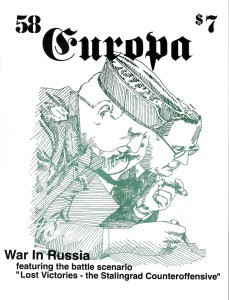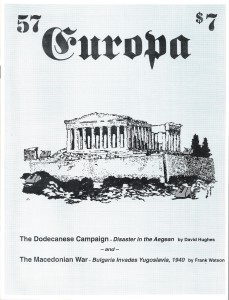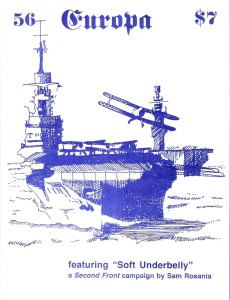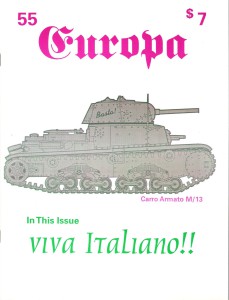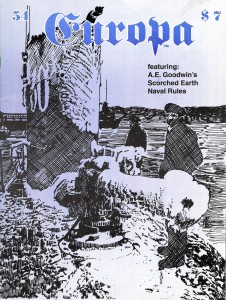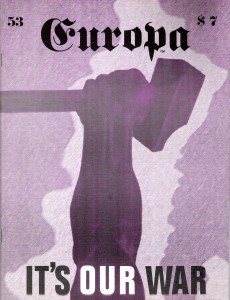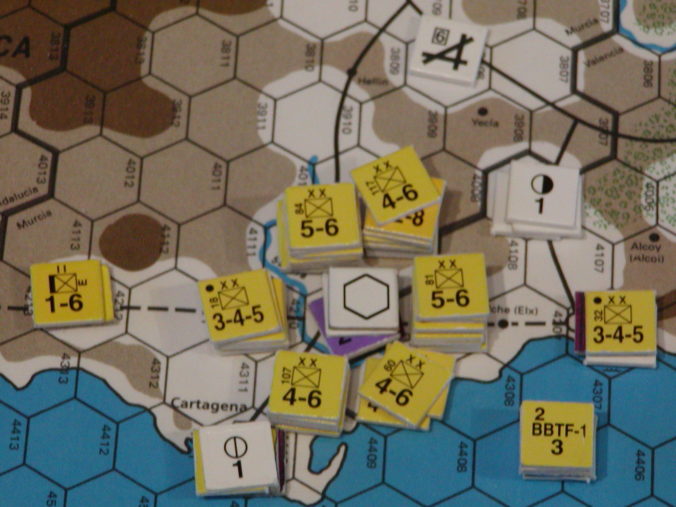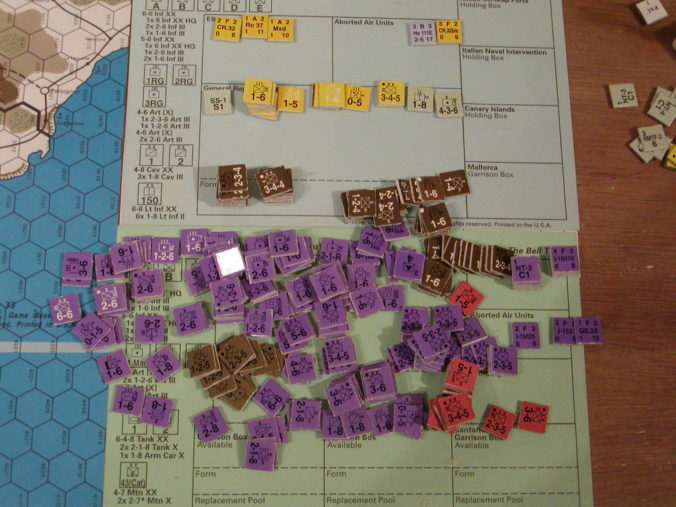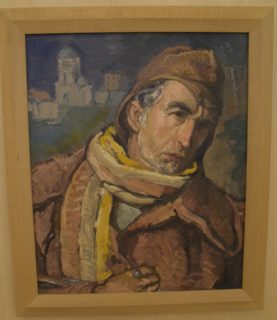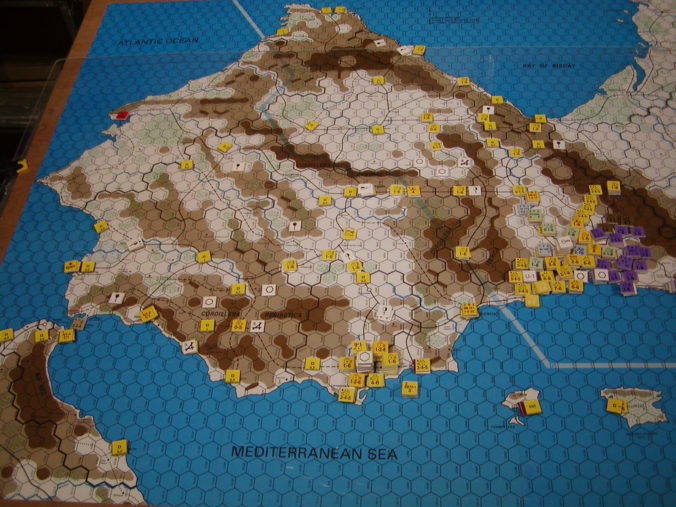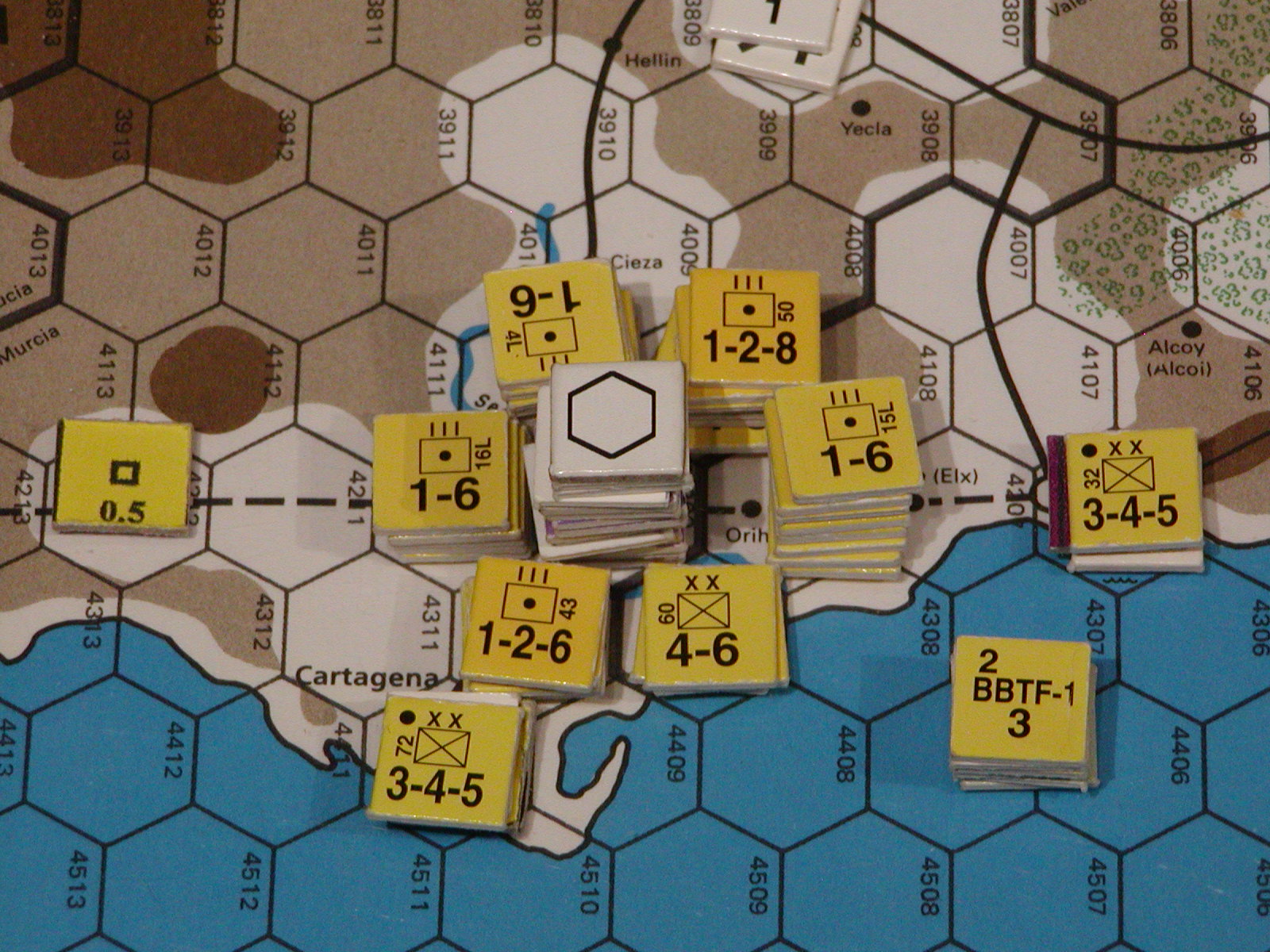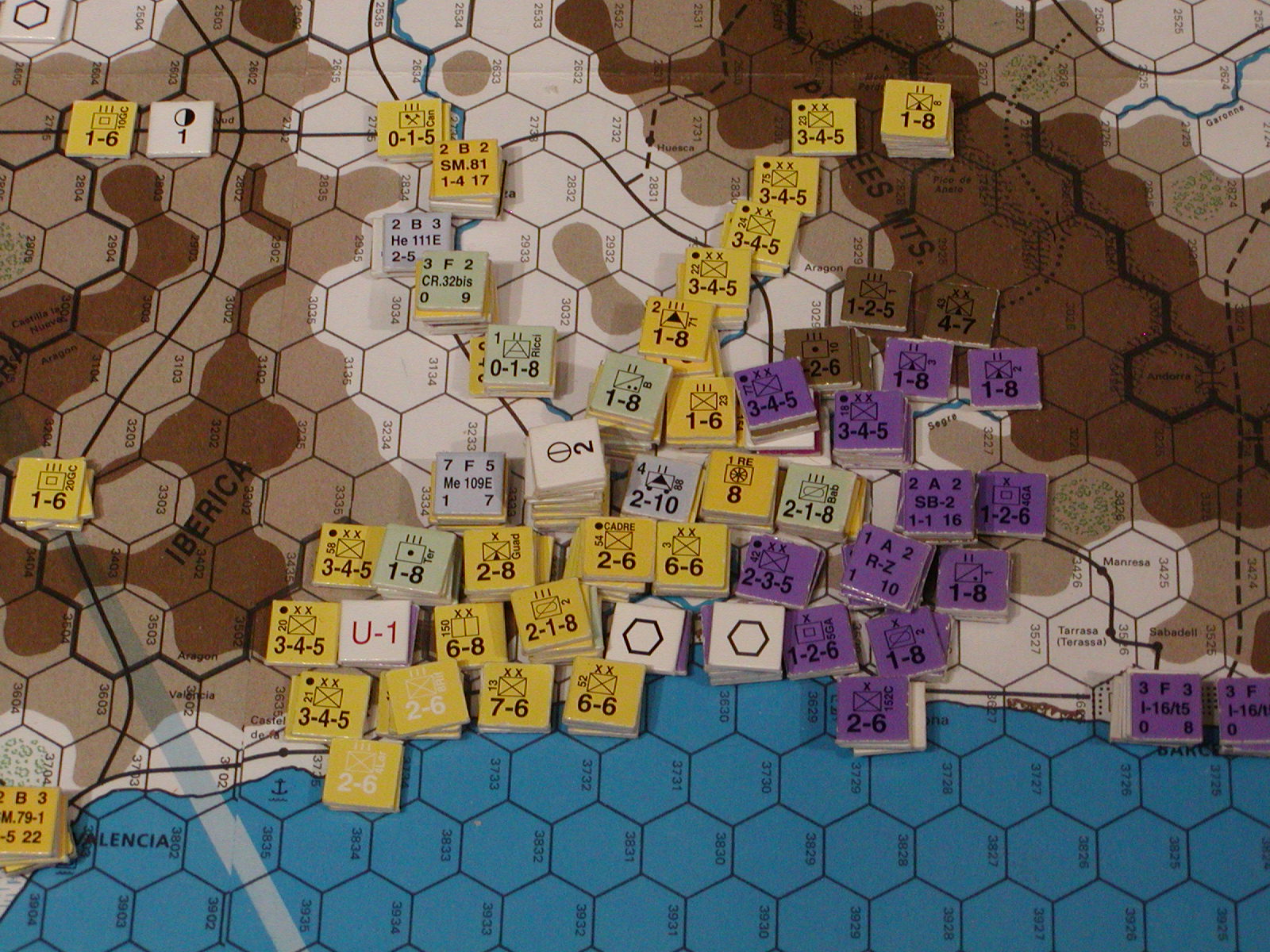Nationalists Turn
Weather; Clear skies across land and sea. D=C. E=C, A= C, M= C
Supply: 12 REs of the defenders in Murcia city draw and expend the last supply from GSPs.
Do 17E replaced. G.50 (CTV), CR.32bis (CTV) repaired
Airfield At 3333 augmented to 6 capacity
Movement: 1 Res pt spent to temporarily increase Rail Cap to 27 REs
Air Activity: Sortie 1: Me109E (KL), HE 51, He 111B, Do 17E, 2B3 deliver 5 GSPs to 3328 unoposed.Sortie2: 3624 (Eastern Barcelona) Unescorted SM.81 SM.79-1 on airfield bombing mission intercepted by I-16/t5 who engages the SM.79-I. No result. Bombs miss target.
Sortie 3: SM.79-I, SM.79-I (CTV), HE 111E (KL) fly Terror bombing to Barcelona. The He 111E (KL) is aborted by the intercepting I-16/t5. The remaining bombers score 2 Hits (N +4 VPs)
Attack 1: 3028 mtn (n of Lerida) Unsupplied 1-8 mtns 7,8, 1-8 mtn art 2 and 3-4-5* inf XXs, 24, 75, 1-6 inf 22, 1-6 inf I-S (Col), 2-1-8 art O and 3-4-5* inf XXs 12, 74, 1-6 inf 27, 1-6 art 12L, 1-8 cav VMS (Fal) Attack 1-2-5 inf 1 (CAT) @ 6:1 (-2) = DH. Advance 24, 75 XXs.
Attack 2: 3531 rough/fort/over river (Tortosa) Unsupplied 6-8 lt 150, 5-6 inf XXs 51, 71, 3-2-6 inf 1LE, 2-6 inf 10BT (Col), 2-1-6 cav 2O (Col), 2-6 art 1P, 2-1-8 art E and 7-8 inf XX 13, 5-6 inf XXs 61, 82, 2-6 infs 5Alh, Tdi (Col), 2-6 art 4P and 6-6 inf XX 52, 102, 2-6 inf 2Mel ~(Col), 2-3-6 art 62, 1-6 arts 10L. 11L and 5-6 inf XX 11, 4-6 inf XX 85, 2-6 infs 8Rif, 6Xau, 4Lar (Col), 2-1-8 cav1E (Col). 1-2-6 art 48 Attack 3-4-5* inf XX 27CM @ 6@1 (-2) = DR. Eliminated as no retreat path. Advance 13, 52, 102 XXs, 6Xau, 8Rif, 4La (Col), 4P, 62 art. Fort destroyed.
Attack 4: 3229 clear (Lerida). Supplied 2-8 mtn Guad, 5-6 inf XX 53, 4-8 cav 1, 3-2-6 inf 2LE, Unsupplied 2-6 eng AM, 4-6 inf XX 83, 1-2-6 art 49, 1-6 art 2 and (over river) 4-5-5 inf XX 50, 4-6 inf XX 154, 2-6* inf cadre 54, 2-6 infs 3Ceu, 7Lam(Col),, supplied 4-6 XX FV (Mxd), 1-8 mot art L (CTV), 1-8 art Ter (CTV) and (over river) 3-1-2 sge art Man (CTV), 4-6 art 3RG, 3-2-6 inf 3LE, unsupplied 6-6 inf XXs 3, 4, 152, 2-1-8 lt tks 2,3 and 2 pts GS from 1A2 Mxd. Attack 3-4-5* inf XXs 77, 30(Cat), 1-2-6 18, o.5 Garrison (unsupported) @ 4:1 = DE. Advance 53 XX, 2LE, Guad mtn, 2, 49 art, AM cons. Fort destroyed 2X AS destroyed, Garrison dispersed.
Attack 5: clear (SE Lerdia). $ Points AA form 88 (KL) fires at DAS 2X SB-2 Returning one.
Supplied6-6 inf XXs 5, 63, 108, 4-6 arts 1RG, 2RG (Transported), 3-2-8 lt tk N, 2-1-8 lt tk Bab (CTV), 2-10 aa 88 (KL) attack 3-4-5* inf XX 74 (Cat), 1-8 lt tk 1, 2-6 nvl 95, 1-6 inf 16, 1-6 eng 4, 1-6 mg 3, 1-2-6 art 2, 1pt DAS @ 2:1 (+1) = DH!. Lose 95 nvl, 1 lt tk
4 eng ,16 inf 16, 3 mg. Advance 63, 108.

Jul II 1939 – Lerida and Tortosa fall
Republican Turn
VPs : Goberneto none collapse (R+5 VPs) None Surrender( R+10 VPs)
Guerrillas;Hit the rail junction at Aranjuez.
Supply: Western Zone: 12 REs @ Murcia Cty U4 all GSPs and Ass exhausted so roll for elimination: 2-6 nvl is unafect4ed, all 3 divisions eliminated* 2 tk, 15 art are eliminated.
Interesting rules point are attected divisions completly eliminated or reduced to cadre? Rule 9E Cadres specifies “in combat”, Rule 13 Overuns specifically states they are not formed yet Rule 12 Supply is moot on the point. I rule that they are NOT formed on the bais that this is not combat and combat staying power does not make you any less lilely to starve.)
Eastern Zone: Isolated 3-6* at 3534 U2.
Replacements; 3.5 SRP, 1 SRP (Cat) recovered. R-Z Rebuilt..
Air Activity: sortie 1: R-Z, SB-2bis fly DAS to 3427
Sortie2: R-Z flies DAS to 3428
Sortie 3: The last Sortie of the war 2x SB-2 fly DAS to 3327
Moves: The mighty fortress of Murcia is reduced to a ptiful rump which can be overrun.
The Republic’s northern flank is constrained by The Nationalist drive due East and can only move one hexand is thus unable to aid the more critical defenders south of the penetration.
The Republic thin the main line still further to get an overrun proof second line.
The line is thinner than last turn and the Nationalists will inevitably take another hex towards Barcelona and force the Catalans to collapse and thus end the game.
BUT the Nationalists , of course, have no more turns left to do this.
The Republic has survived by one hex and one turn.
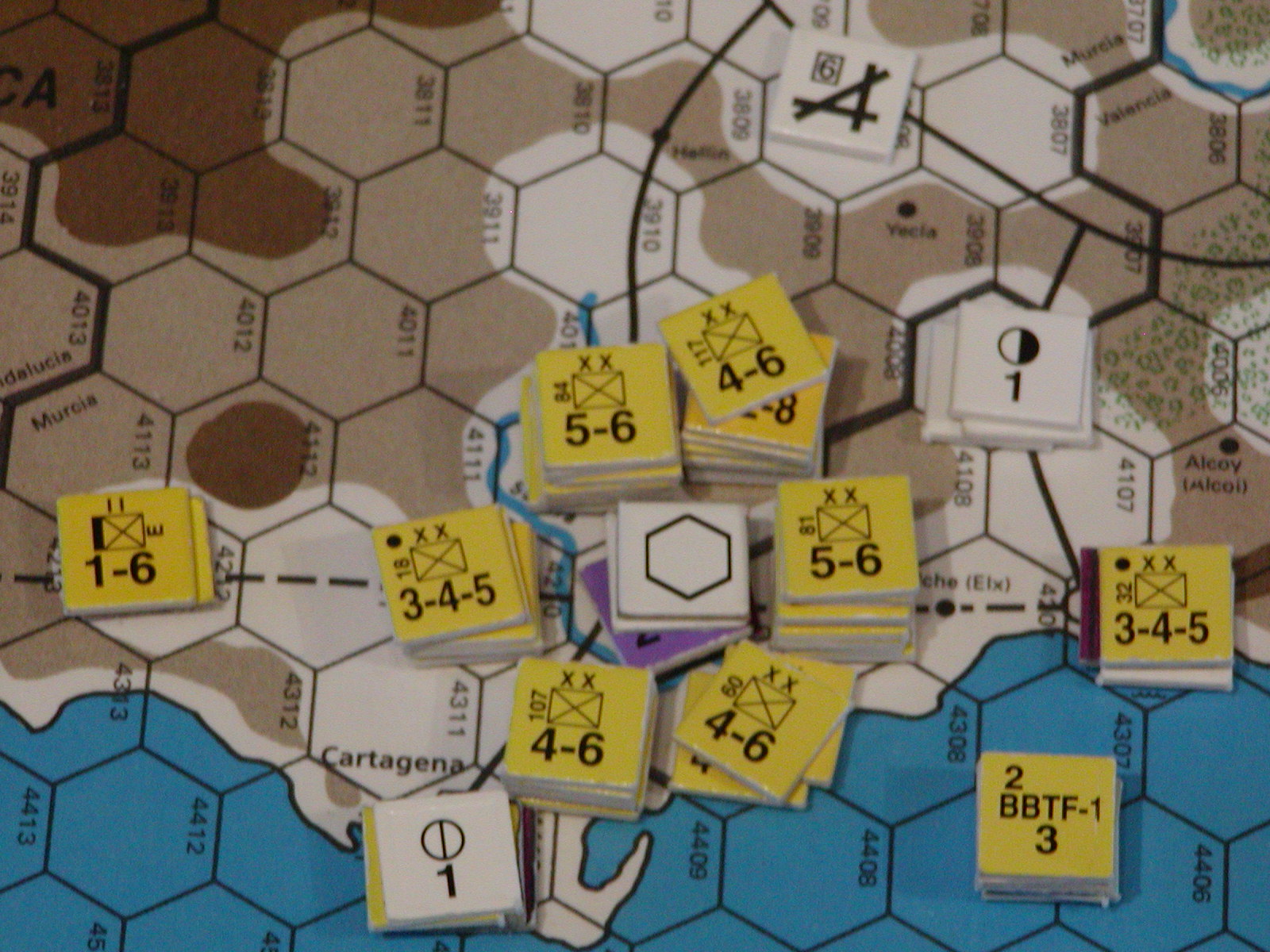
Jul II 1939: Murcia garrison reduced by famine
